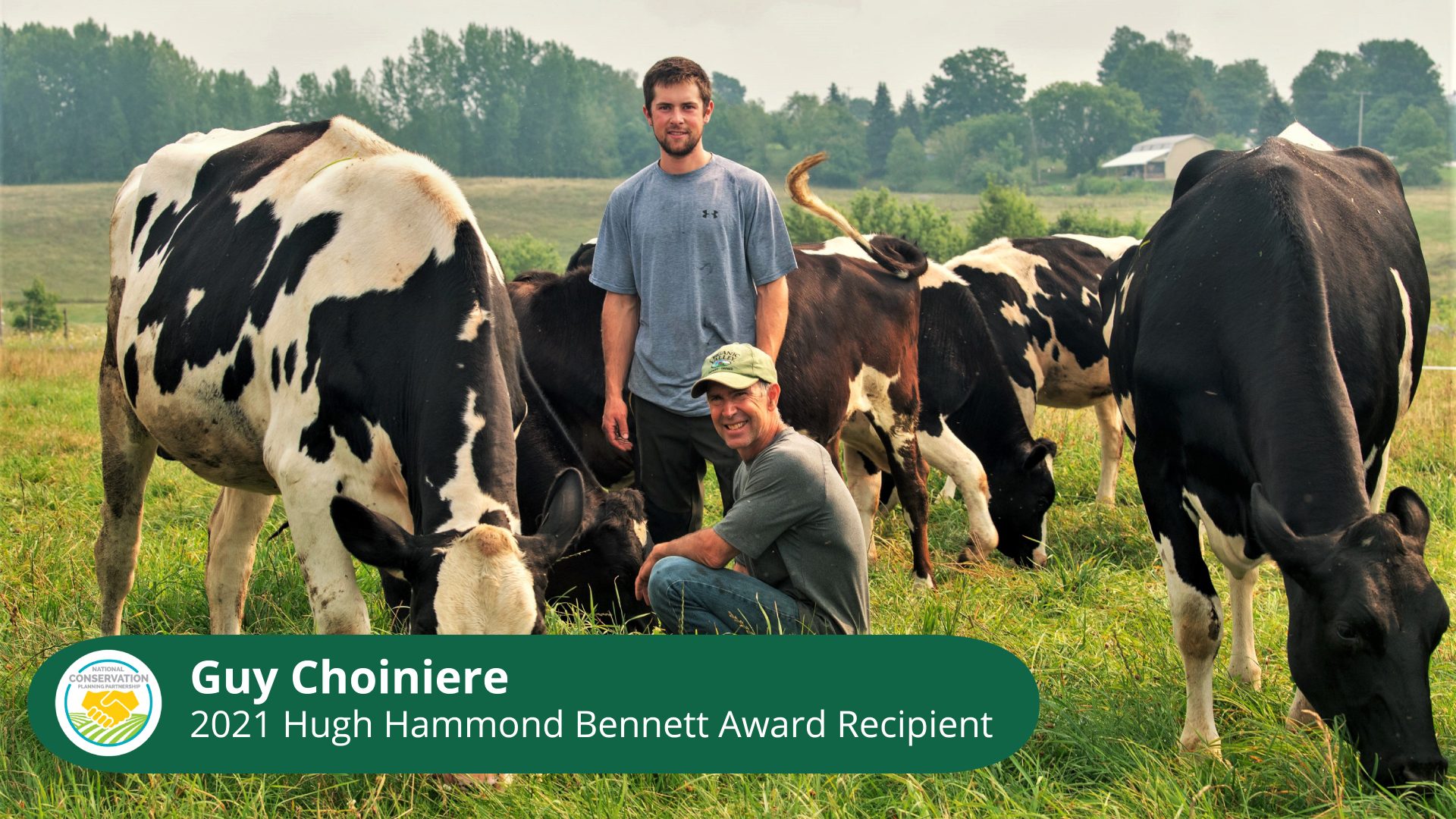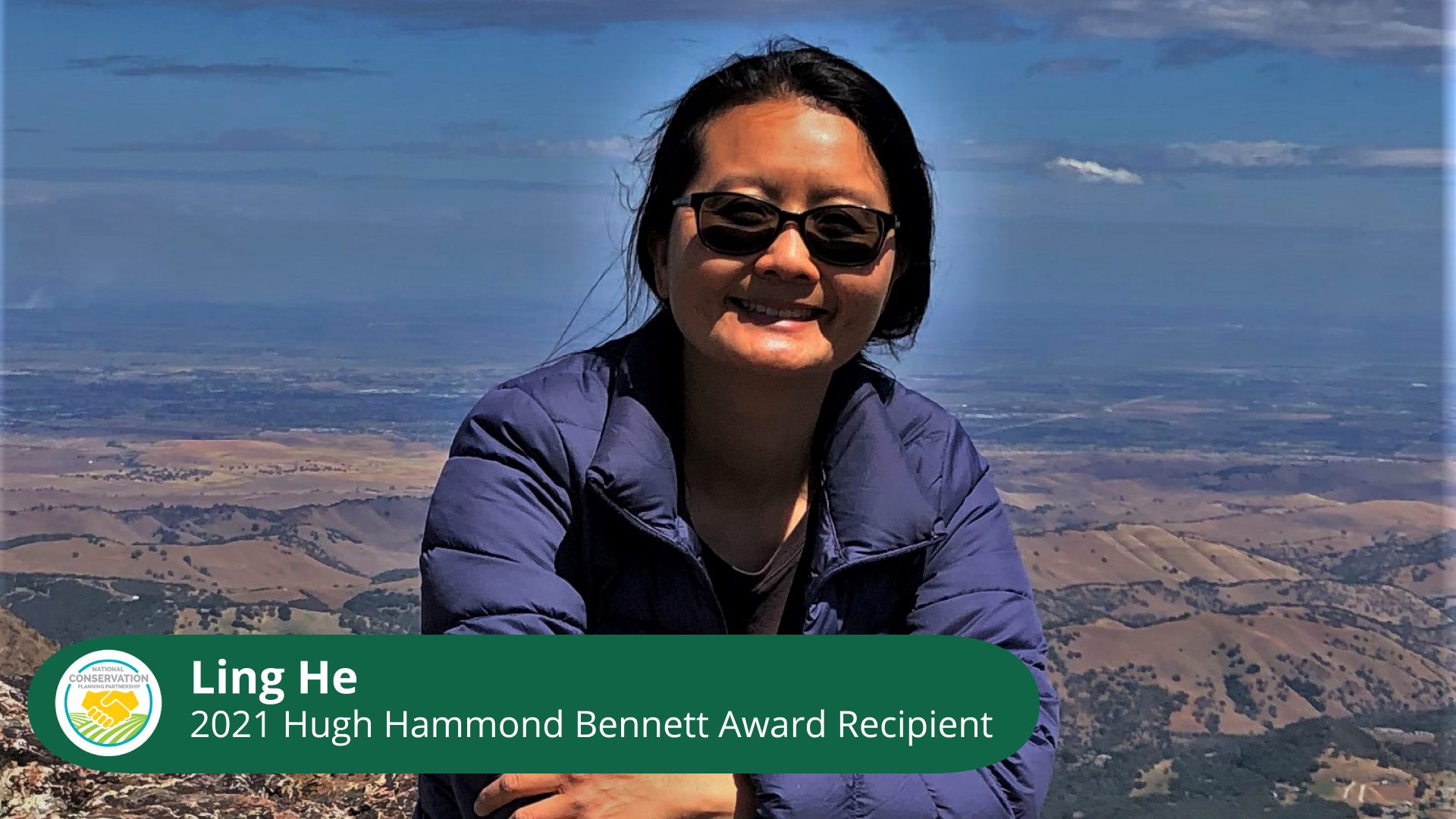2021 National HHB Award Winners
Conservation Producer Recipient

Guy Choiniere has been named the winner of the Conservation Producer 2021 Hugh Hammond Bennett Award for Conservation Excellence for their outstanding conservation efforts on their farm, Choiniere Family Farm, in Highgate, Vermont.
Choiniere says the health of the soil is the health of the farm. This land ethic drives his actions on a dairy farm that’s been in the Choiniere family since 1945. While navigating changes in the farm economy, climate and farming practices, the Choiniere Family Farm has become a model of innovation and adaptability for other New England dairies. Soil health and erosion control practices have kept the farm productive and resilient despite an increase in severe storms, rainfall, and periods of drought in northwest Vermont.
Justin Tuthill, Vermont USDA’s Natural Resources Conservation Service (NRCS) Acting State Conservationist says, “The Choiniere’s commitment to conservation planning and protecting soil and water resources is an inspiration to NRCS, and Choiniere has been an instrumental and passionate spokesperson for the important role of soil health in Vermont.”
Prompted by an unstable market for conventional milk in the 1990s, Choiniere studied and then transitioned to organic production. It’s a move he said was good for his cows, land, and the bottom line. A few years later he seeded 25 acres of corn to permanent hay and pasture in order to convert his herd to 100% grass-fed. That move fetched an even better price for their organic milk.
After taking over the farm, Choiniere also began addressing environmental issues with assistance from NRCS. The conservation plan he developed remains a work in progress today. To prevent soil erosion and improve water quality, the Choinieres planted 5,000 trees along banks of the impaired Rock River. They also conveyed a 51-acre river corridor easement that designates an area where the river can meander naturally. The land can still be farmed, but the river will not be dredged. There is also a permanent 50-foot naturally vegetated buffer along 12,000 feet of the river’s bank.
Keeping nutrients on the farm and out of the river was also aided when Choiniere switched from conventional liquid manure storage to an innovative compost bedded pack system. During the winter, the cows are fed hay in large hoop barns designed to mimic the comfort and atmosphere of being on pasture. Excess hay provides bedding and catches manure before being trod down into compost. When the cows resume rotational grazing in May, pigs are let into the barns to root around and expedite the composting process before it is spread on fields as nutrient-rich fertilizer. Choiniere is an ambassador to help other dairies manage bedded pack systems.
Sarah Larose, NRCS Vermont Soil Conservationist said, “The Choiniere Family Farm is one of the most deserving farms for this prestigious award, and they have enhanced their conservation efforts for decades, now spanning over three generations. Their willingness to listen, learn, and implement conservation practices is commendable.”
The Choiniere Family Farm participates in Vermont’s roadside sign program that identifies conservation practices like rotational grazing, cover crops, no-till and streamside plantings. The Choinieres, who were Vermont’s Conservation Farmers of the Year in 2009, were also selected as recipients of the 2021 New England Leopold Conservation Award.
Jill Arace, Executive Director of the Vermont Association of Conservation Districts said, "We're grateful to the Choiniere family for their careful stewardship of the land and close attention to soil health and water quality as they produce the healthy milk we drink. And we're glad to be part of the community of organizations that have helped this farm be a model for others and achieve this important recognition. 'It takes a village' as they say, and many organizations provided technical and financial assistance to help the Choiniere family both build a successful dairy operation and achieve their conservation goals. This assistance, often supported with public funds, is available to farmers throughout Vermont and beyond, and is an important part of the equation of supporting family farms, growing our nation's food, preserving our beautiful landscape, and protecting the environment for future generations."
Conservation Planner Recipient

Ling He, a Rangeland Management Specialist for USDA’s Natural Resources Conservation Service (NRCS) in Alameda County, California, has been named the winner of the Conservation Planner 2021 Hugh Hammond Bennett Award for Conservation Excellence for her outstanding efforts as a conservation planner.
“I am surprised and excited to receive the [Hugh Hammond Bennett] award. Thanks to the National Conservation Planning Partnership for the recognition and high honor. I’m feeling humble and very grateful for the support and recognition from my agency [NRCS] and colleagues. To me, this award goes to all the people I work with, my NRCS and RCD colleagues, local conservation partners, as well as the producers,” says He.
He serves in Livermore, California, covering all of Alameda County in the east San Francisco Bay area. She has worked in the Livermore Local Partnership Office for thirteen years and has been a certified conservation planner for over eight years. She serves as the office lead for addressing rangeland and plant-related issues and also manages the Conservation Stewardship Program (CSP) for multiple rangeland clients. In 2018, she became a Certified Rangeland Manager, a professional certification provided by the California-Pacific Section of the Society for Range Management (CalPac-SRM), further demonstrating her abilities in this field.
He spends much of her spare time hiking and exploring the beautiful open spaces of the Bay Area. Her personal interests ultimately benefit her professional accomplishments, as she knows the landscapes, the growth patterns of our local plant communities, and sees the changes throughout the years. She brings that enthusiasm and awareness to each of our clients, providing recommendations that help achieve their individual goals.
He frequently provides translation support to Chinese producers in neighboring counties, such as Santa Clara, San Benito, and San Francisco counties. She provided translation assistance to Chinese producers at multiple workshops cohosted by University of California Cooperative Extension (UCCE), Loma Prieta Regional Conservation District (RCD), and NRCS on Water Quality Regulation, Weed Management, and Nutrient Management. She volunteered to provide translation review for five program appendices that were translated into Chinese.
He is a member of the Monarch Plant Material Work Group and the East Bay Monarch Work Group. Her involvement contributes to high-quality technical assistance for NRCS clients in weed management, plant selection and establishment, monitoring of milkweed and nectar plantings, and general technical support for the Alameda County Conservation Partnership’s Monarch Program to help partners and ranchers increase habitat for this declining species.
He collaborates closely with the Alameda County Resource Conservation District on several annual monitoring projects and assists with complex vegetation-related projects. She led and completed vegetation and photo monitoring for four riparian restoration sites and has coordinated with clients and subcontractors on maintenance activities with adaptive management strategies. She has also assisted with educational projects for local students.
As part of a larger-scale effort to improve the access and utilization of public lands for grazing, He served as facilitator and technical expert during negotiations between a local water agency and their grazing lessee. She assisted with a review of the grazing lease agreements, interviews of agency staff, and literature reviews. Much of Alameda County’s viable rangeland is owned by public agencies and leased to private ranchers. Her efforts help to ensure fair and equitable processes which ultimately result in better management of these critical lands.
